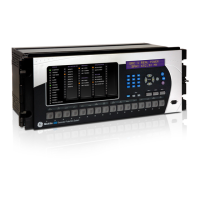GE Multilin G60 Generator Protection System 2-1
2 PRODUCT DESCRIPTION 2.1 INTRODUCTION
2
2 PRODUCT DESCRIPTION 2.1INTRODUCTION 2.1.1 OVERVIEW
The G60 Generator Protection System is a microprocessor based relay that provides protection, monitoring, control, and
recording functions for AC generators driven by steam, gas, or hydraulic turbine. Current, voltage and frequency protection
are provided along with fault diagnostics.
Voltage, current, and power metering is built into the relay as a standard feature. Current parameters are available as total
waveform RMS magnitude, or as fundamental frequency only RMS magnitude and angle (phasor).
Diagnostic features include an event recorder capable of storing 1024 time-tagged events, oscillography capable of storing
up to 64 records with programmable trigger, content and sampling rate, and data logger acquisition of up to 16 channels,
with programmable content and sampling rate. The internal clock used for time-tagging can be synchronized with an IRIG-
B signal or via the SNTP protocol over the Ethernet port. This precise time stamping allows the sequence of events to be
determined throughout the system. Events can also be programmed (via FlexLogic™ equations) to trigger oscillography
data capture which may be set to record the measured parameters before and after the event for viewing on a personal
computer (PC). These tools significantly reduce troubleshooting time and simplify report generation in the event of a sys-
tem fault.
A faceplate RS232 port may be used to connect to a PC for the programming of settings and the monitoring of actual val-
ues. A variety of communications modules are available. Two rear RS485 ports allow independent access by operating and
engineering staff. All serial ports use the Modbus
®
RTU protocol. The RS485 ports may be connected to system computers
with baud rates up to 115.2 kbps. The RS232 port has a fixed baud rate of 19.2 kbps. Optional communications modules
include a 10Base-F Ethernet interface which can be used to provide fast, reliable communications in noisy environments.
Another option provides two 10Base-F fiber optic ports for redundancy. The Ethernet port supports IEC 61850, Modbus
®
/
TCP, and TFTP protocols, and allows access to the relay via any standard web browser (G60 web pages). The IEC 60870-
5-104 protocol is supported on the Ethernet port. DNP 3.0 and IEC 60870-5-104 cannot be enabled at the same time.
The G60 IEDs use flash memory technology which allows field upgrading as new features are added. The following Single
line diagram illustrates the relay functionality using ANSI (American National Standards Institute) device numbers.
Table 2–1: ANSI DEVICE NUMBERS AND FUNCTIONS
DEVICE
NUMBER
FUNCTION DEVICE
NUMBER
FUNCTION
21P Phase distance backup 59N Neutral overvoltage
24 Volts per hertz 59P Phase overvoltage
25 Synchrocheck 59X Auxiliary overvoltage
27P Phase undervoltage 59_2 Negative-sequence overvoltage
27TN Third harmonic neutral undervoltage 64F Field ground protection
27X Auxiliary undervoltage 64S Sub-harmonic stator ground protection
32 Sensitive directional power 64TN 100% stator ground
40 Loss of excitation 67_2 Negative-sequence directional overcurrent
46 Generator unbalance 67N Neutral directional overcurrent
49 Thermal overload (RTD) 67P Phase directional overcurrent
50G Ground instantaneous overcurrent 68/78 Power swing detection
50N Neutral instantaneous overcurrent 81A Frequency out-of-band accumulation
50P Phase instantaneous overcurrent 81O Overfrequency
50SP Split phase protection 81R Rate of change of frequency
50/27 Accidental energization 81U Underfrequency
51G Ground time overcurrent 87G Restricted ground fault
51P Phase time overcurrent 87S Stator differential

